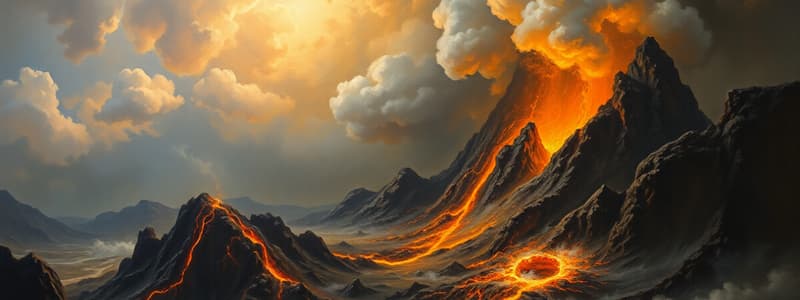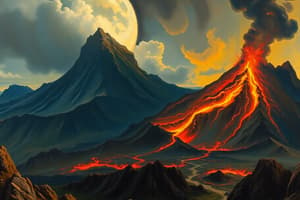Podcast
Questions and Answers
How does the behavior of S-waves provide evidence about the Earth's interior?
How does the behavior of S-waves provide evidence about the Earth's interior?
- Their speed increases in the outer core, confirming its solid composition.
- They reflect off the inner core, showing it is made of different materials.
- They cannot travel through the outer core, indicating its liquid state. (correct)
- Their speed decreases in the mantle, indicating a change in density.
Which of the following scenarios best describes the tectonic processes at a convergent boundary involving an oceanic plate and a continental plate?
Which of the following scenarios best describes the tectonic processes at a convergent boundary involving an oceanic plate and a continental plate?
- The oceanic plate subducts under the continental plate, leading to the formation of a volcanic arc. (correct)
- Both plates move apart, allowing for sea-floor spreading and the creation of new crust.
- The continental plate subducts under the oceanic plate, forming a mid-ocean ridge.
- Both plates collide and uplift, creating a transform fault.
How does the Richter scale magnitude relate to the energy released by an earthquake?
How does the Richter scale magnitude relate to the energy released by an earthquake?
- Each whole number increase on the Richter scale represents a tenfold increase in energy released.
- Each whole number increase on the Richter scale represents an approximate 32-fold increase in energy released. (correct)
- Each whole number increase on the Richter scale represents a linear increase in energy released.
- The Richter scale directly measures ground movement, not energy released.
What is the primary difference between magma and lava, and where are they typically found?
What is the primary difference between magma and lava, and where are they typically found?
Which type of fault is most commonly associated with compressional forces and can result in the shortening of the Earth's crust?
Which type of fault is most commonly associated with compressional forces and can result in the shortening of the Earth's crust?
What is the key characteristic that differentiates a dormant volcano from an extinct volcano?
What is the key characteristic that differentiates a dormant volcano from an extinct volcano?
How do convection currents within the Earth's mantle contribute to plate tectonics?
How do convection currents within the Earth's mantle contribute to plate tectonics?
What geological feature is typically formed at a divergent boundary on the ocean floor?
What geological feature is typically formed at a divergent boundary on the ocean floor?
Which plate boundary type is characterized by plates sliding past each other horizontally, neither creating nor destroying crust?
Which plate boundary type is characterized by plates sliding past each other horizontally, neither creating nor destroying crust?
How do P-waves and S-waves differ in their propagation through the Earth, and what does this tell us about Earth's interior?
How do P-waves and S-waves differ in their propagation through the Earth, and what does this tell us about Earth's interior?
What type of earthquake wave is most responsible for causing damage to structures on the Earth's surface?
What type of earthquake wave is most responsible for causing damage to structures on the Earth's surface?
Which of the following statements best describes the relationship between the focus and epicenter of an earthquake?
Which of the following statements best describes the relationship between the focus and epicenter of an earthquake?
How do 'black smokers' contribute to the chemical composition of the surrounding ocean water?
How do 'black smokers' contribute to the chemical composition of the surrounding ocean water?
If a seismograph detects a significant delay between the arrival of P-waves and S-waves from an earthquake, what can be inferred about the distance to the earthquake's epicenter?
If a seismograph detects a significant delay between the arrival of P-waves and S-waves from an earthquake, what can be inferred about the distance to the earthquake's epicenter?
What force is most directly responsible for the formation of a normal fault?
What force is most directly responsible for the formation of a normal fault?
Flashcards
Volcano
Volcano
A landscape feature where melted rock erupts onto Earth's surface.
Magma
Magma
Extremely hot liquid or semi-liquid rock within the mantle; called lava when it erupts.
Lava
Lava
Extremely hot liquid or semi-liquid rock from the mantle that flows or erupts on Earth's surface.
Hotspot
Hotspot
Signup and view all the flashcards
Black Smoker
Black Smoker
Signup and view all the flashcards
Active Volcano
Active Volcano
Signup and view all the flashcards
Dormant Volcano
Dormant Volcano
Signup and view all the flashcards
Extinct Volcano
Extinct Volcano
Signup and view all the flashcards
Caldera
Caldera
Signup and view all the flashcards
Seismograph
Seismograph
Signup and view all the flashcards
Richter Scale
Richter Scale
Signup and view all the flashcards
Fault
Fault
Signup and view all the flashcards
Compression
Compression
Signup and view all the flashcards
Tension
Tension
Signup and view all the flashcards
Earthquakes
Earthquakes
Signup and view all the flashcards
Study Notes
- Volcanoes are landscape features where melted rock erupts onto the Earth's surface.
- Magma is extremely hot liquid or semi-liquid rock within the mantle.
- Lava is magma that has reached the Earth's surface.
- Hotspots are volcanic regions above anomalously hot mantle areas.
- Black smokers are geothermal vents on the seafloor ejecting superheated, mineral-rich water.
- Active volcanoes are currently erupting or have recently erupted.
- Dormant volcanoes have erupted in the last 10,000 years and are likely to erupt again.
- Extinct volcanoes have not erupted in the last 10,000 years and are not expected to erupt again.
- A caldera is a large, cauldron-like hollow formed after a magma chamber empties during a volcanic eruption.
- A seismograph is an instrument used to detect and measure the intensity of an earthquake.
- The Richter scale is a logarithmic scale that measures the energy released during an earthquake.
- Folding occurs when rocks bend into anticlines or synclines.
- An anticline is a fold in a rock with the narrow point facing upwards.
- A syncline is a fold in a rock with the narrow point facing downwards.
- A fault is a break in the crust where one side moves relative to the other.
- Compression is a squeezing force.
- Tension is a stretching force.
- Shearing is a smearing force.
- A reverse fault is a break where the rock above the fault moves up due to compression.
- A normal fault is a break where the rock above the fault moves down due to tension.
- A strike-slip fault is a break where rocks move horizontally due to shearing.
Earthquakes
- Tremors are minor vibrations of the ground that are commonly not felt.
- Earthquakes are sudden and violent shaking of the ground.
- The focus is the underground location of the fault movement causing an earthquake.
- The epicenter is the surface point directly above the earthquake focus.
- Body waves are seismic waves that quickly travel through the Earth's interior.
- Surface waves are seismic waves that travel slower and only along the surface.
- P-waves (primary waves) are compressional body waves and are the fastest.
- S-waves (secondary waves) are transverse body waves, slower than P-waves, and cannot travel through fluids.
- A tsunami is a powerful ocean wave triggered by an undersea earth movement.
Ocean Features
- Abyssal plains are relatively flat underwater deep ocean floors, around 4000 meters deep.
- Ocean ridges are submarine mountains that tower 2000 meters above the abyssal plains.
- Ocean trenches are narrow and deep troughs in the ocean floor, generally greater than 5000 meters deep.
- Sea-floor spreading is the formation of oceanic crust by rising and melting mantle at ocean ridges.
- Plate tectonics describes the movements and interaction of the Earth's crust plates.
- Convection currents are the movement of particles in a liquid or gas due to temperature or density differences.
- A convergent boundary is where two tectonic plates move towards each other.
- Subduction is a convergent plate boundary where one plate moves under another.
- Collision occurs when two continents crumple together to form a mountain range.
- A mountain range is a group of high ground features, commonly from tectonic collision.
- A divergent boundary is where two tectonic plates move apart.
- A constructive plate boundary is where new crust is formed.
- A transform boundary is where two tectonic plates slide past one another.
- A conservative plate boundary is where crust is neither created nor destroyed.
Earth's Structure
- The crust is the hard and thin outer rock layer of the Earth.
- The mantle is the solid but soft middle rock layer of the Earth.
- The core is the hot center of the Earth made of iron and nickel.
- The outer core is the liquid outer layer of the core, about 2300 km thick.
- The inner core is the solid innermost layer under extreme pressure, with an approximate 1200 km radius.
Studying That Suits You
Use AI to generate personalized quizzes and flashcards to suit your learning preferences.




